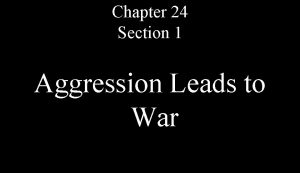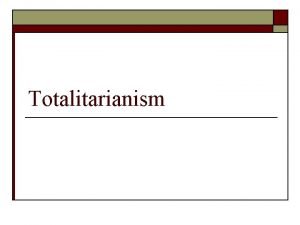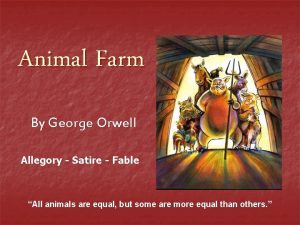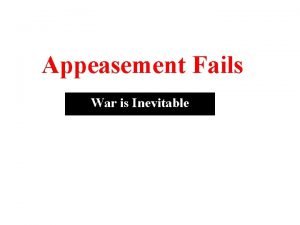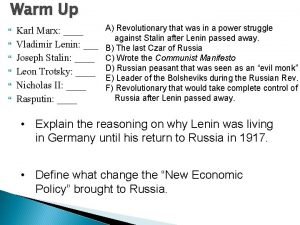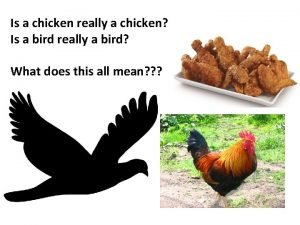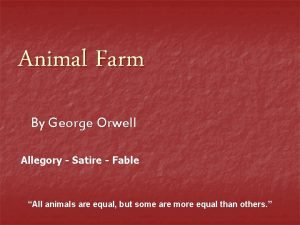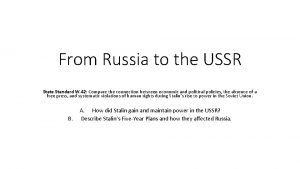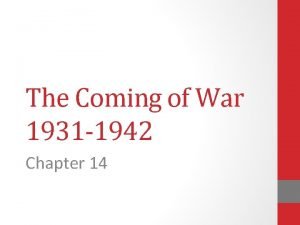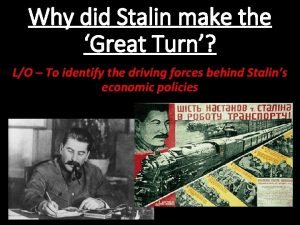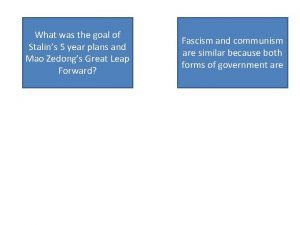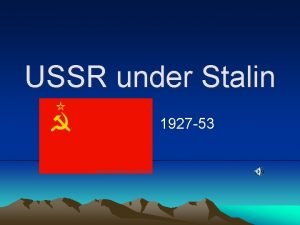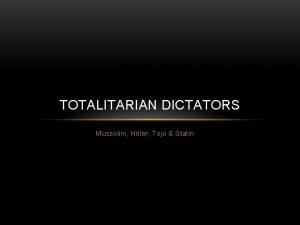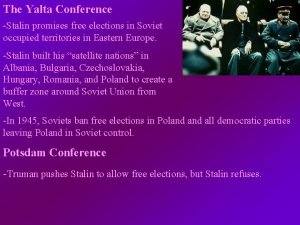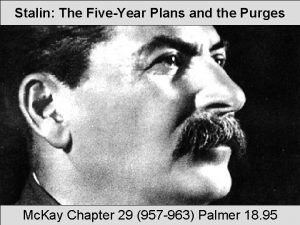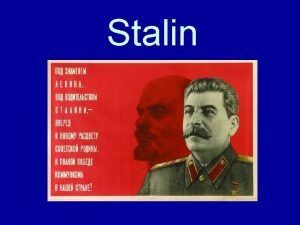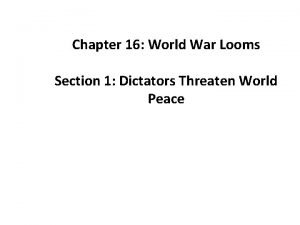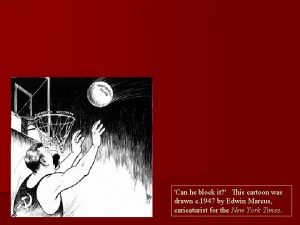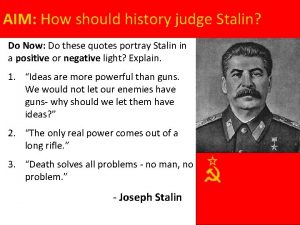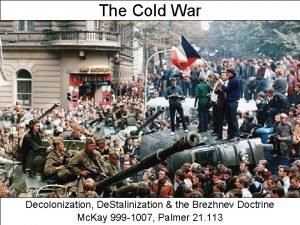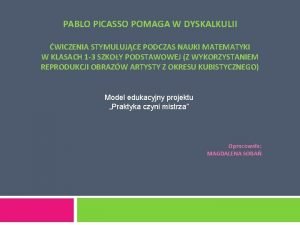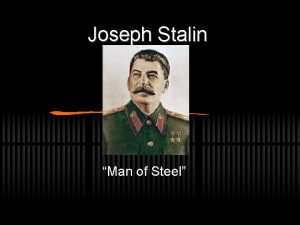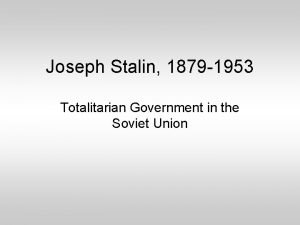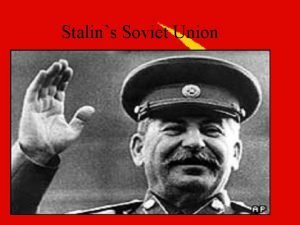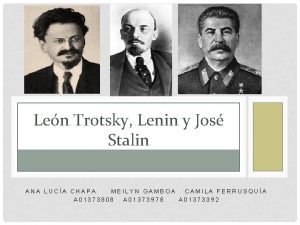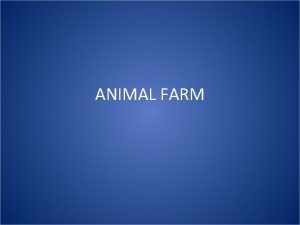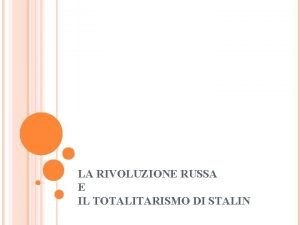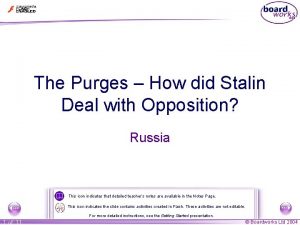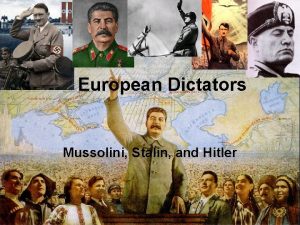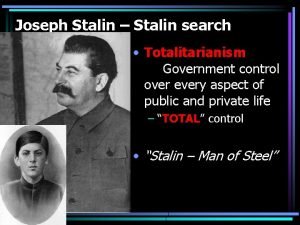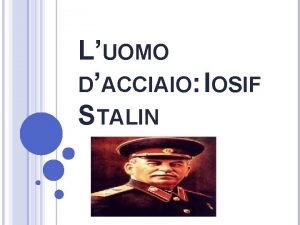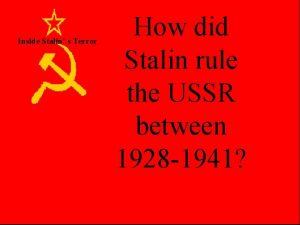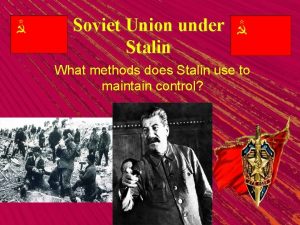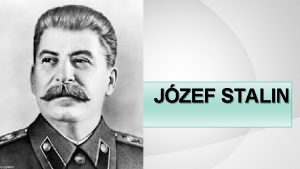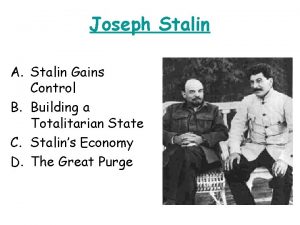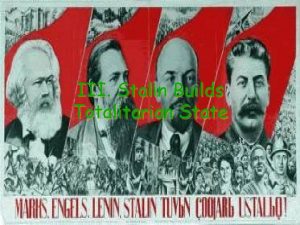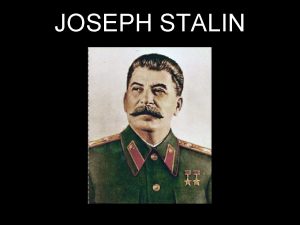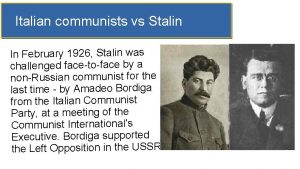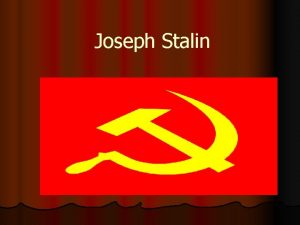Stalin The FiveYear Plans and the Purges Mc




























- Slides: 28

Stalin: The Five-Year Plans and the Purges Mc. Kay Chapter 29 (957 -963) Palmer 18. 95

Today’s Agenda • Finish Stalin Revolution • Objective Test on WWI to Russian Revolution Thursday • Corrected DBQs due tomorrow

Totalitarian dictatorships • • Emerged in Soviet Union, Germany, and Italy Rejected parliamentary and liberal values (including rationality, rationality peaceful progress, economic freedom, freedom and a strong middle class) class State regulates nearly every aspect of public and private behavior Characterized by – secret police – propaganda disseminated through the state-controlled mass media – personality cults – regulation and restriction of free discussion and criticism – single-party states – use of mass surveillance – terror tactics – Extreme nationalism sought full control & mobilize over the masses believed in will power, conflict, the worship of violence USSR was totalitarianism of the left Nazi Germany was totalitarianism of the right

• • • Review 1860 s- Era of Reform – Fundamental Institutions altered • Serfdom ended • Zemstvos 1890 s – Reactionary period (Alexander III) – Stolypin Policies • Industrialization • Kulaks supported – Political Parties Form • Kadets • Populists • Social Democratic Party – Mensheviks – Bolsheviks » Marxists-Leninists 1905 – Russo Japanese War – Bloody Sunday – October Manifesto • Duma • 1914 (WWI) • 1917 – February Rev. (March) • Petrograd Food Riots • Provisional Gov v Petro. Sov • May – Army Order #1 – October Rev. (Nov) • Peace, Land Bread • 1918 -Brest Litovsk • 1918 -1922 - Civil War – Red Army • War Communism – Cheka – Red Terror • 1921 -1927 – New Economic Policy (NEP) (1924 – Stalin v Trotsky

Crane Brinton & The Anatomy of Revolution Moderate Period • Feb-Oct 1917 • “Age of Montesquieu” • Constitution – Liberal moderate s Kadets (nobles & bourgeois ie) in control • Provisional Gov. • Duma • Limited Change • Limited enfranchisement • Legal equality, not social • • • Radical Period Oct 1917 -1921 “Age of Rousseau” Republic – Strong central government – Radicals in control Bolshevik Rev. Radical Revolutionary Change Total enfranchisement Terror (Cheka) Regicide Command economy (War Communism) Utopian/ idealized vision • • • Radical Thermidorian Period Revolution Reignited 1921 -1927 “Age of Smith” • 1921 -1953 • “Stalin’s Oligarchy Revolution” • Gov. pro • 5 Year Plans Bourgeoisie • Collectivization (Kulak) • Forced New Economic Industrialization Policy • Great Purges Idealized visions • Liquidation of of Rev forgotten Counter. Revolutionaries – Period of decadence Free Market economy – High Inflation

Stalin’s Soviet Union Great Purges Russian Revolution 1917 1921 -Red Army defeats White Army -NEP begins Lenin Dies 1924 1927 Stalin Emerges as the Leader Collectivization Begins 1929 1936 First Five Year Plan (1928) Operation Barbarossa 1939 Molotov Ribbentropp Pact 1941

The New Economic Policy, 1921 – 1927 • A strategic retreat • By 1920 the country is in ruins • “War Communism” had antagonized peasants • Produced only 62% of pre. Revolution land • Also dealing with drought, famine, transportation problems, WWI, Revolution, Civil War, The Terror, ‘war communism” – 50 -90% in 17 provinces starving – Steel & textile production only 4% of 1913 levels • Millions died • Lenin – believed that revolution (socialism) was going to fast – ordered a compromise with capitalism (a strategic retreat)

The New Economic Policy, 1921 – 1927 • A relaxation of the Terror and tempo of the socialist movement • State still controlled the “commanding heights” of the economy – Banks, RR, heavy industry • But allowed private trading for private profit • Effort was intended to increase trade between town and country – Peasants could sell excess produce for manufactured goods • NEP was pro Kulak – Led to the growth of a Neo-bourgeois • Nouveau riches in a classless society • Reached 1913 level of production by 1926 • A thermidorian period?

Stalin and Trotsky • Lenin died in 1924 Lenin after series of strokes (54 years old) • Had been incapacitated for 2 years before death • Trotsky and Stalin were top two candidates for position • Stalin (background) – Expelled from theological seminary – Joined Bolsheviks in 1903 – Poor speaker, writer – Appointed General Secretary of Communist Party • Not viewed as very influential post (at first) • Used it to appoint allies – Good organizer, palm greaser Click for Clip (0 -6 min)

Stalin and Trotsky • Trotsky – Colorful and bombastic ideologue – Called for permanent revolution • Communism must spread • Girondistic weltanschauung – Called forceful industrialization and collectivization of agriculture – Demanded the adoption of an overall “Plan” Plan • Stalin – Covert, subtle, politically practical – Called for “socialism in one country” • Montagnardic weltanschauung – 95 percent of the party delegates voted for Stalin at the party congress (1927) • Trotsky was exiled and banished to Siberia • Lived in Turkey, France, and Mexico • Organized an underground against Stalin • Was murdered in Mexico in 1940 • Name not mentioned in Russian textbooks until 1980 s

The First Five-Year Plan (1928 -32) • Known as second revolution & “Revolution from above” above • Aim was to make nation militarily and industrially self-sufficient – Stalin (1929)-”We are becoming a country of metal, a country of automobiles, a country of tractors…” – Declared fulfilled in 1932 • Second 5 Year Plan (’ 32 -37) • Third 5 Year Plan (’ 38 - WWII) • Plan listed economic goals – 250% increase in industrial output – 150% increase in agricultural output "The Victory of the Five Year Plan is a Strike Against Capitalism"

The First Five-Year Plan (1928 -32) • Gosplan – Planned the economy – Answered all economic questions – how much to produce – amount of capital to produce – amount of consumer goods – wages, prices – Created a command & planned economy • Why? – Stalin feared Thermidorian (capitalism) – Wanted to catch up to the West – Feared establishment of conservative landowning peasantry This poster from 1929 attacks eight groups that were frequently scapegoated (clockwise from top left): landlords, kulaks, journalists, capitalists, White Russians, Mensheviks, priests, and drunkards

Goals of the First Five Year Plan • Main goal of 1 st 5 – Build up heavy industry without foreign loans – Make USSR self sufficient • History offered no paradigm of going from agriculture to industrial based economy without borrowing capital – GB industrialization aided by Dutch investment – GB first had agricultural revolution (land enclosure, scientific cultivation) – This released rural population to find employment in factories • 1 st Five attempted similar feat without landowning class • How? "Long live the international socialist revolution!"

The Collectivization of Agriculture • Collectivization (1928 -1940) – Part of 1 st 5 Year Plan to convert small, privately owned farms into large, collectively owned farms – peasantry would become proletariat (owned no capital, employed no labor individually) • Goals: – Increase food supply – Free up labor factory work • Collective farms – a few thousand acres each – Kolkhozy • owned by peasants themselves (the collective) • Paid tax in produce • Mir paradigm – Sovkhozy • State owned • Mass produced one product Soviet Collectivization Propaganda (1930). The poster reads "Hey Friend, Come with us into the Collective!"

Effects of Collectivization • Before 1928 – average peasant was too poor to afford a tractor, tractor fields too small and dispersed • After Collectivization – Machine Tractors Stations – organized throughout country with expert agronomist, agronomist a fleet of tractors, combines • Each collective was assigned a quota • Almost whole nation was collectivized by 1939 • Was Collectivization successful? – Did free up labor (20 million) to work in cities (industrialization) – Did not increase food production • Denied peasants freedom to make their own economic decision, killed incentive to improve land, passing land to offspring

Collectivization in Soviet Union 1927 -1940

Human Costs of Collectivization • Kulaks (large landowning peasants) resistance Click for clip (8: 34 -15 – Viewed collectivization as the “Second Serfdom” • • – Stalin said “liquidate them as a class” Kulaks slaughtered horses, cattle, pigs, rather than give them up (50%) Loss of animals was worst unforeseen calamity Stalin still refused to cut back on cereal and food exports because they were needed to pay for industrial imports (under 1 st 5 Year Plan) millions were killed/others transported to labor camps in Siberia Many of the most capable farmers perished Led to deadly famine in southeast Russia and Ukraine in ’ 32 -’ 33 6 Millions died Soviet Collectivization Village Propaganda(1929): The Poster Reads "On our collective there is no room for priests or kulaks"

The Growth of Industry • Greatest industrial growth in 10 year period in history • GB growth was gradual, Germany and US it was rapid (USSR was light speed) speed – 1928 -38 USSR increased production of iron and steel 4 xs, coal 3. 5 xs, became largest producer of farm tractors, RR locomotives • Plants of Magnitogorsk in the Urals and Stalinsk in Siberia produced as much iron and steel as the whole Russia empire did in 1914 • Only the US and Germany had greater gross industrial output in 1939 – Plans called for development of industry east of Urals (Asia) – Copper mines near Lake Balkhash, lead mines in Altai Mountains were developed • Grain producing regions developed in Siberia and Kazakh • Tashkent (formerly remote village in Uzbek) grew to city of. 5 million and a hub of cotton, copper mining, electrical industries • RR of ’ 38 carried 5 xs that of 1913 Early Soviet poster: The Smoke of chimneys is the breath of Soviet Russia

Changes Brought by Modernization • Incredibly inner Asia was turning industrial • USSR was carrying on more trade with its Asian neighbors (although less foreign trade than in 1914) • Industrialization in the Urals and Asia saved Russia in ’ 41 (Barbarossa) Barbarossa • BUT – it’s easy to exaggerate USSR’s industrialization • Started from almost nothing • Low standards of production (shoddy work) • Low efficiency and output compared to West • Produced less coal, electricity, cotton, woolens, leather shoes, and steel per capita than almost all Western nations • Paper is good indicator (index) of Let's make stronger industrialization, “civilizing activities” industrial power of Soviet • 1937 US = 103 pounds person Union ! 1932 • Germany and GB= 92 • Japan= 17 • Russia = 11

Social Costs and Effects of the Plans • Soviet citizens had to forgo consumer goods – Lack of quality food, housing, – Kulaks and others who resisted were killed • 1/3 rd of national income was reinvested in industry every year – Hard work for low wages • Morale sustained by propaganda • • Late 1930 s life began to ease food rationing abolished (1935) More products (dishes, pens) began to appear Living standards = 1927 levels Threat of war and need for preparation kyboshed the utopian dream Socialism did eliminate some of capitalisms evils – No acknowledged unemployment – No cycle of boom and depression – No exploitation of children, women – No extremely wealthy class But no economic equality (actually great difference in income) Govern officials, managers, engineers, artists, and intellectuals of the Party were rewarded

Competition • Alexey Stakhanov – Coal miner who was propagandized as a “Hero of Socialist Labor” • mined a record 102 tons of coal in under 6 hours – 14 times his quota • Greatly increased his wages (piece rate) • Led to increased competition as other compe workers began to set production records • Stakhanovites (labor heroes) were held up by government (IE. A production line speed up) • Factory managers who failed to reach their quota (profit) could lose job, status, or life • Poor management was viewed as sabotage or a betrayal of Soviet society • Press denounced those who didn’t meet the plan Soviet Medal for Labor Valor

The Price of Solidarity • Feeling of building a socialist motherland was prevalent • Became national pastime to watch the mounting statistics, fulfilling of quotas – Instead of sports, readers read about the economy • This solidarity came with totalitarianism • Gov supervised everything • No room for skeptics, independence of thought • No one could leave country without permission (given rarely) ( • No free labor union, no free press, association, only slight toleration of religion • Jews harassed • Untold millions perished, were imprisoned, forced labor camps in Stalin’s juggernaut Shaming: Winners of the "infamous banner for a tortoise's pace. "

Socialist Realism • Officially approved art of the Communist Party • Loaded with propaganda • A reaction against “decadent bourgeois art of impressionism and cubism • purpose was to elevate the common worker • Factory and agricultural worker – presenting his life, work, and recreation as admirable – ultimate aim was to create New Soviet Man – “Man will make it his purpose to master his own feelings, to raise his instincts to the heights of consciousness, to make them transparent, to extend the wires of his will into hidden recesses, and thereby to raise himself to a new plain plane, to create a higher social biologic type, or, if you please, a superman. ” Soviet poet Vladimir Mayakovsky: Who needs a "1"? The voice o a "1" is thinner than a squeak. Who will hear it? Only the wife. . . A "1" is nonsense. A "1" is zero.

Constitution of 1936 • New constitution proclaimed in 1936 (because socialism was so successful) • Gave rights – employment, rest, leisure, economic security, social security • Condemned racism, racism gave equal and universal suffrage • At first applauded in the west • Communist Party remained sole governing group • Diverging opinions within the Party led to conspiracy (since one could not question Stalin himself)

The Great Purges • Series of “Show Trials” between 1936 -38 of Old Bolsheviks accused of traitorous activities – Trying to assassinate Stalin – Restore capitalism – Dismember Soviet Union – Being part of "Trotskyite Terrorist Centre" • Verdicts predetermined • “Confessed” their crimes after torture & threats to family members and promptly executed by firing squad

The Great Purges • Began when Serge Kirov, Kirov old friend of Stalin and head of Lenigrad party apparatus, Politburo member was assassinated in his office – Actually murdered by Stalin’s men for showing signs of dissention – Stalin used this assassination as excuse for further terror • Over 100 Bolsheviks executed • KGB later disclosed that from 1930 -1953 3, 778, 334 persons had been tried for crimes against the state • Most of them during Great Terror of 1934 -38 • 786, 098 were executed • Unknown others died in labor/prison camps • Gulag Archipelago – Soviet forced labor and concentration camp system Click for Stalin Documentary


Reinforcing the Dictatorship • Stalin rid himself of the Old Bols who knew Lenin and potential rivals • Young revolutionaries were products of the new order • Didn’t question Stalin’s dictatorship Click for Clip 6: 50 (5 Year Plan)
 Aggressive actions taken in the 1920s and 1930s
Aggressive actions taken in the 1920s and 1930s Lenin dies and stalin comes to power
Lenin dies and stalin comes to power Animal farm joseph stalin
Animal farm joseph stalin Hitler and stalin
Hitler and stalin Karl marx vladimir lenin and joseph stalin
Karl marx vladimir lenin and joseph stalin Stalin and the chicken example
Stalin and the chicken example Leon trotsky animal farm
Leon trotsky animal farm How did stalin gain and maintain power in the ussr?
How did stalin gain and maintain power in the ussr? How did stalin and mussolini maintain their power
How did stalin and mussolini maintain their power Stalin great turn
Stalin great turn What was the goal of stalin's 5 year plan
What was the goal of stalin's 5 year plan Where was stalin born
Where was stalin born What did tojo do to people who opposed him
What did tojo do to people who opposed him Stalin promise free elections
Stalin promise free elections Collectivization
Collectivization 1924 stalin becomes soviet dictator
1924 stalin becomes soviet dictator Stalin vs mussolini venn diagram
Stalin vs mussolini venn diagram Edwin marcus can he block it
Edwin marcus can he block it As a small boy how did the author regard stalin
As a small boy how did the author regard stalin Stalin
Stalin Pablo picasso portret dory maar
Pablo picasso portret dory maar Young joseph stalin
Young joseph stalin Stalin comes to power
Stalin comes to power Stalin's totalitarian state industrial policies
Stalin's totalitarian state industrial policies Joseph stalin apush
Joseph stalin apush Stalin
Stalin Jos stalin
Jos stalin Hitler stalin mao
Hitler stalin mao La rivoluzione russa e il totalitarismo di stalin
La rivoluzione russa e il totalitarismo di stalin
